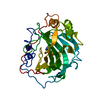+検索条件
-Structure paper
| タイトル | Docking 14 million virtual isoquinuclidines against the mu and kappa opioid receptors reveals dual antagonists-inverse agonists with reduced withdrawal effects. |
|---|---|
| ジャーナル・号・ページ | bioRxiv, Year 2025 |
| 掲載日 | 2025年1月14日 |
 著者 著者 | Seth F Vigneron / Shohei Ohno / Joao Braz / Joseph Y Kim / Oh Sang Kweon / Chase Webb / Christian Billesbølle / Karnika Bhardwaj / John Irwin / Aashish Manglik / Allan I Basbaum / Jonathan A Ellman / Brian K Shoichet /  |
| PubMed 要旨 | Large library docking of tangible molecules has revealed potent ligands across many targets. While make-on-demand libraries now exceed 75 billion enumerated molecules, their synthetic routes are ...Large library docking of tangible molecules has revealed potent ligands across many targets. While make-on-demand libraries now exceed 75 billion enumerated molecules, their synthetic routes are dominated by a few reaction types, reducing diversity and inevitably leaving many interesting bioactive-like chemotypes unexplored. Here, we investigate the large-scale enumeration and targeted docking of isoquinuclidines. These "natural-product-like" molecules are rare in the current libraries and are functionally congested, making them interesting as receptor probes. Using a modular, four-component reaction scheme, we built and docked a virtual library of over 14.6 million isoquinuclidines against both the μ- and -opioid receptors (MOR and KOR, respectively). Synthesis and experimental testing of 18 prioritized compounds found nine ligands with low μM affinities. Structure-based optimization revealed low- and sub-nM antagonists and inverse agonists targeting both receptors. Cryo-electron microscopy (cryoEM) structures illuminate the origins of activity on each target. In mouse behavioral studies, a potent member of the series with joint MOR-antagonist and KOR-inverse-agonist activity reversed morphine-induced analgesia, phenocopying the MOR-selective anti-overdose agent naloxone. Encouragingly, the new molecule induced less severe opioid-induced withdrawal symptoms compared to naloxone during withdrawal precipitation, and did not induce conditioned-place aversion, likely reflecting a reduction of dysphoria due to the compound's KOR-inverse agonism. The strengths and weaknesses of bespoke library docking, and of docking for opioid receptor polypharmacology, will be considered. |
 リンク リンク |  bioRxiv / bioRxiv /  PubMed:39868130 / PubMed:39868130 /  PubMed Central PubMed Central |
| 手法 | EM (単粒子) |
| 解像度 | 2.96 - 3.9 Å |
| 構造データ | EMDB-48524, PDB-9mqh: EMDB-48525: Inactive Mu-Opioid Receptor with Nb6M, NabFab, and isoquinuclidine compound#020_E1 EMDB-48526, PDB-9mqj: EMDB-48527, PDB-9mqk: EMDB-48528, PDB-9mql: |
| 化合物 |  PDB-1bnm: |
| 由来 |
|
 キーワード キーワード | MEMBRANE PROTEIN / G-protein coupled receptor / Mu-opioid / isoquinuclidine / antagonist / nanobodies / fabs / Kappa-opioid |
 ムービー
ムービー コントローラー
コントローラー 構造ビューア
構造ビューア 万見文献について
万見文献について













 homo sapiens (ヒト)
homo sapiens (ヒト)
